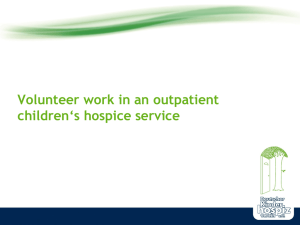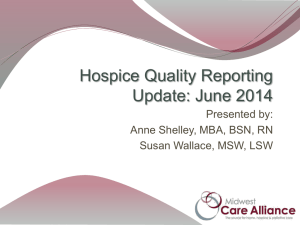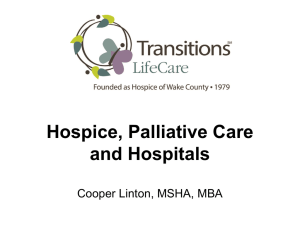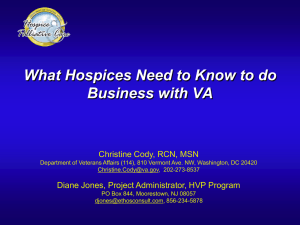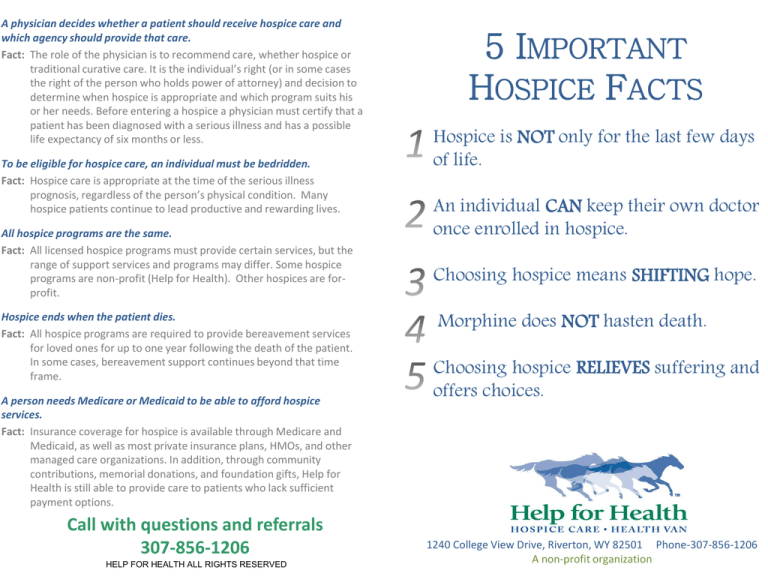
A physician decides whether a patient should receive hospice care and
which agency should provide that care.
Fact: The role of the physician is to recommend care, whether hospice or
traditional curative care. It is the individual’s right (or in some cases
the right of the person who holds power of attorney) and decision to
determine when hospice is appropriate and which program suits his
or her needs. Before entering a hospice a physician must certify that a
patient has been diagnosed with a serious illness and has a possible
life expectancy of six months or less.
To be eligible for hospice care, an individual must be bedridden.
Fact: Hospice care is appropriate at the time of the serious illness
prognosis, regardless of the person’s physical condition. Many
hospice patients continue to lead productive and rewarding lives.
All hospice programs are the same.
Fact: All licensed hospice programs must provide certain services, but the
range of support services and programs may differ. Some hospice
programs are non-profit (Help for Health). Other hospices are forprofit.
Hospice ends when the patient dies.
Fact: All hospice programs are required to provide bereavement services
for loved ones for up to one year following the death of the patient.
In some cases, bereavement support continues beyond that time
frame.
A person needs Medicare or Medicaid to be able to afford hospice
services.
Fact: Insurance coverage for hospice is available through Medicare and
Medicaid, as well as most private insurance plans, HMOs, and other
managed care organizations. In addition, through community
contributions, memorial donations, and foundation gifts, Help for
Health is still able to provide care to patients who lack sufficient
payment options.
Call with questions and referrals
307-856-1206
HELP FOR HEALTH ALL RIGHTS RESERVED
5 IMPORTANT
HOSPICE FACTS
1. Hospice is NOT only for the last few days
of life.
2. An individual CAN keep their own doctor
once enrolled in hospice.
3. Choosing hospice means SHIFTING hope.
4. Morphine does NOT hasten death.
5. Choosing hospice RELIEVES suffering and
offers choices.
1240 College View Drive, Riverton, WY 82501 Phone-307-856-1206
A non-profit organization
Dispelling 5 Common Myths
Other common myths:
MYTH – Hospice is just for the last days of life.
Receiving hospice care does not mean the patient is giving up hope or
that death is imminent. The earlier an individual receives hospice
care, the more opportunity there is to stabilize their medical
condition and address other needs. Often, people can feel better
after admission to hospice because uncontrolled symptoms can be
well managed after many months or years of being poorly managed.
Hospice is a place.
Fact: Hospice care usually takes place in the comfort of an individual's
home, but can be provided in any environment in which a person
lives, including a nursing home, assisted living facility, or residential
care facility.
MYTH - An individual cannot keep their own doctor once enrolled in
hospice.
Hospice reinforces the patient-primary physician relationship by
advocating either office or home visits, according to the physician’s
preference. Hospices work closely with the primary physician and
consider the continuation of the patient-physician relationship to be
of the highest priority.
Individuals must have a Do-Not-Resuscitate to be in hospice.
Fact: Hospice philosophy honors people where they are at with advanced
directives. As a part of care planning the hospice team will offer
support and education regarding what directives like CPR and
intubation may really mean for a person with a terminal diagnosis.
Often, individuals that begin hospice with CPR directives and other
wishes for life saving measures will change their wishes as they
learn more about the outcomes of such interventions.
MYTH - Choosing hospice means giving up hope.
When faced with a serious illness, many patients and family members
tend to dwell on the imminent loss of life rather than on making the
most of the life that remains. Hospice helps patients reclaim the spirit
of life. It helps them understand that even though death can lead to
sadness, anger, and pain, it can also lead to opportunities for
reminiscence, laughter, reunion, and hope.
MYTH – Hospice gives morphine to hasten death.
Not all hospice patients are on morphine. Morphine, and other similar
narcotics, are given to control pain or breathing difficulties in patients
that benefit from such medication for comfort. Research has shown
that morphine does not hasten death when given to provide comfort
at the end of life.
MYTH - Choosing hospice means stopping all medical treatment.
The focus of hospice is comfort. Most medications that individuals
receive provide comfort in one way or another, or may cause
discomfort if removed from a patient’s regimen. Hospice allows
individuals to stay on their medications as long as it is not an
aggressive/curative treatment towards their hospice diagnosis.
Hospice pays for all hospice/comfort related medications. Individuals
may stay on medications not related to their terminal diagnosis and
can expect their insurance to continue to cover those medications.
Reviewing medications and appropriate treatments is on a case by
case basis. Individuals always have the right to reinstate traditional
care at any time, for any reason. If a person’s condition improves or
the disease goes into remission, he or she can be discharged from
hospice and return to aggressive, curative measures, if so desired.
Hospice is only for people with cancer.
Fact: A large number of hospice patients have congestive heart failure,
Alzheimer's disease or dementia, chronic lung disease, or other
conditions.
Individuals can only receive hospice services for a limited amount of
time.
Fact: The Medicare benefit, and most private insurance, pays for hospice
care as long as the patient continues to meets the criteria necessary.
Patients may come on and off hospice care, and re-enroll in hospice
care, as needed.
Hospice is just for the patient.
Fact: Hospice focuses on comfort, dignity, and emotional support. The
quality of life for the patient, family members and other caregivers,
is the highest priority.
After six months, patients are no longer eligible to receive hospice care.
Fact: According to the Medicare hospice program, services may be
provided to seriously ill individuals with a life expectancy of six
months or less. However, if the person lives beyond the initial six
months, he or she can continue receiving hospice care as long as the
attending physician recertifies that the patient is seriously ill.


